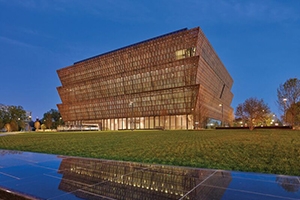In the Community
AU Ties to the National Museum of African American History and Culture

Among other ties, NMAAHC Founding Director Lonnie Bunch is an AU alumnus. Photo Credit: Alan Karchmer/NMAAHC.
The National Museum of African American History and Culture opens on Saturday, September 24. It chronicles the entire African-American experience, from the untold suffering to the historic milestones. The Smithsonian museum itself is a testament to incredible strength and perseverance: Legislation for the project germinated in the 1920s, but a law authorizing partial funding for NMAAHC’s creation was finally signed in 2003.
A few members of the greater American University community have contributed to this endeavor. Here’s a synopsis of some AU connections to the museum.
Lonnie Bunch, the NMAAHC founding director, is an AU alumnus in history (CAS/BA ’74, MA ’76). In March of this year, Bunch appeared at a College of Arts and Sciences event in the Katzen Arts Center. He sat down with AU President Neil Kerwin and discussed his vision of the museum.
“It would be the place where America would get to wrestle with its tortured racial past. It would have to tell the unvarnished truth. It would have to have those moments where you cry over, as you ponder the pain of slavery or segregation. But it had to also help people find the joy that is within this community,” he said.
But that wasn’t enough, he added. “It had to also take African-American culture, and use it as a lens to better understand what it meant to be an American.”
Bunch also reflected on his time here. “There is no doubt that I would not be in this position if it wasn’t for AU,” he said. “I was very fortunate to work with people like Alan Kraut. People who both challenged and nurtured. And what AU did for me was it helped me bring a sense of order and structure to somebody who just loved history, and didn’t really know what you could do with it.”
AU School of Communication professor Russell Williams donated his two Academy Awards, two Emmys, as well as photos and film equipment, to the NMAAHC. A true trailblazer, Williams was the first African American to win two Oscars in any category. He won those awards for sound work in the films Glory (1989) and Dances with Wolves (1990).
Williams, also an AU alum, considered the possibility of donating his awards somewhere on the West Coast, such as the forthcoming Academy Museum of Motion Pictures. But as he explained in a 2015 interview, he has proud roots in Southeast Washington, D.C. “People thought I had lost my mind, but I'm a D.C. guy and I've always loved the Smithsonian. So I'd rather have them here,” he said.
Daniel Sayers, CAS Anthropology Department chair, provided objects for an exhibit on the maroons of the Great Dismal Swamp. Sayers has done meticulous research on maroons—African Americans who escaped enslavement—taking refuge in wooded wetlands in Southeast Virginia and Northeast North Carolina. As detailed in a recent Smithsonian magazine article, this exhibit is part of the Slavery and Freedom gallery.
Alumnus Adam Martin is now a chief digital officer at the NMAAHC. Martin earned his master’s in interactive journalism from AU, and he later taught as an SOC adjunct.
Phil Freelon, father of SOC professor Deen Freelon, was the lead architect for the NMAAHC. An AU Dad connection, if you will.
Deen Freelon recently attended an early museum tour led by his father. In an interview, he shared some of his initial impressions. “I thought it was really, really moving,” he said. “From what I saw, the museum actually did a pretty good job of balancing between the positive achievement aspect of black history and the negative oppression piece of it.”
Indicating the museum’s breadth, Freelon was pleasantly surprised by an exhibit on post-1960s black rock ‘n’ roll acts, such as Fishbone, Living Colour, and Bad Brains.
With time constraints and some parts still under construction, his first tour was just a taste. “I felt like I could spend three, four hours minimum there. I’m really looking forward to the next opportunity I have to come back,” he said.
Freelon is obviously proud of his father’s work. “Every time I go through it, I’ll think about his role there. It’s a part of history.”
Students at AU are in close proximity to the museum. There’s currently information on the NMAAHC site about volunteering and internships/fellowships. Opportunities are apparently limited now, but students can check back at a later date.
AU students in the Frederick Douglass Distinguished Scholars program are attending an opening day dedication at the museum. The first weekend is reportedly sold out, but the location should make it accessible for AU students in the coming months. The closest metro station is Federal Triangle on the blue, orange, and silver lines.


